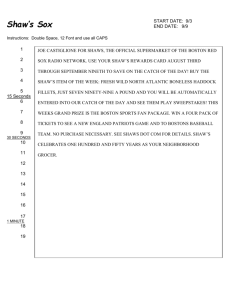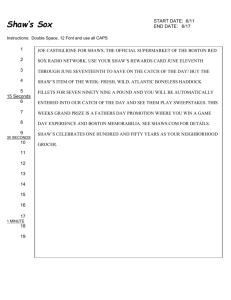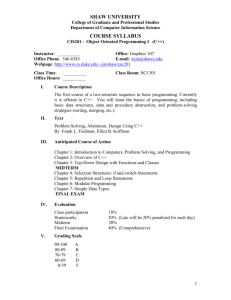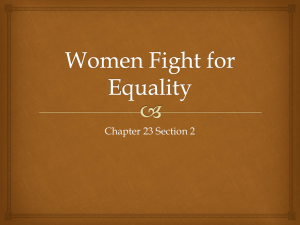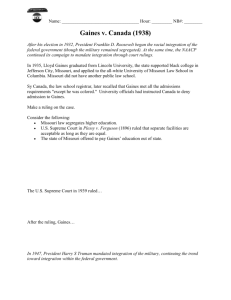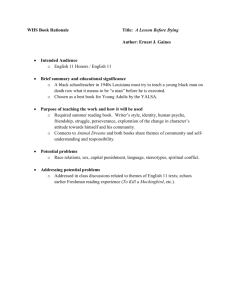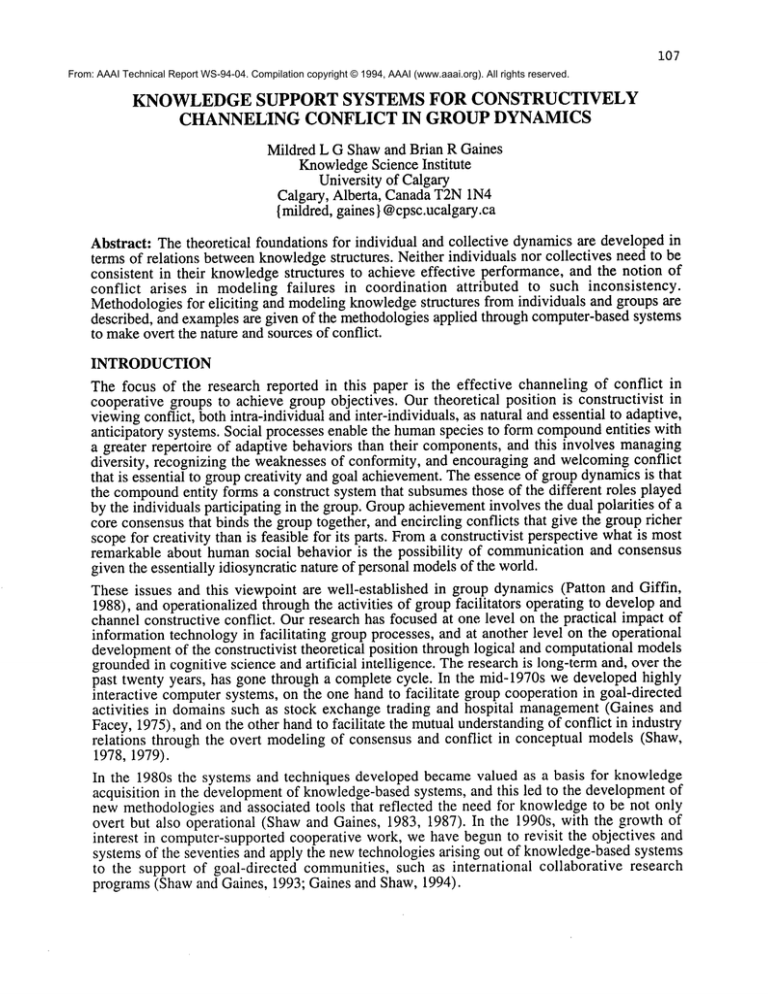
107
From: AAAI Technical Report WS-94-04. Compilation copyright © 1994, AAAI (www.aaai.org). All rights reserved.
KNOWLEDGE SUPPORT SYSTEMS FOR CONSTRUCTIVELY
CHANNELING
CONFLICT
IN GROUP DYNAMICS
Mildred L G Shawand Brian R Gaines
KnowledgeScience Institute
University of Calgary
Calgary, Alberta, Canada T2N1N4
{mildred, gaines} @cpsc.ucalgary.ca
Abstract: The theoretical foundations for individual and collective dynamicsare developed in
terms of relations betweenknowledgestructures. Neither individuals nor collectives need to be
consistent in their knowledgestructures to achieve effective performance, and the notion of
conflict arises in modeling failures in coordination attributed to such inconsistency.
Methodologiesfor eliciting and modelingknowledgestructures from individuals and groups are
described, and examplesare given of the methodologies applied through computer-basedsystems
to makeovert the nature and sources of conflict.
INTRODUCTION
The focus of the research reported in this paper is the effective channeling of conflict in
cooperative groups to achieve group objectives. Our theoretical position is constructivist in
viewingconflict, both intra-individual and inter-individuals, as natural and essential to adaptive,
anticipatory systems. Social processes enable the humanspecies to form compoundentities with
a greater repertoire of adaptive behaviors than their components, and this involves managing
diversity, recognizing the weaknesses of conformity, and encouraging and welcomingconflict
that is essential to group creativity and goal achievement.Theessence of group dynamicsis that
the compoundentity forms a construct system that subsumesthose of the different roles played
by the individuals participating in the group. Groupachievementinvolves the dual polarities of a
core consensusthat binds the group together, and encircling conflicts that give the group richer
scope for creativity than is feasible for its parts. Froma constructivist perspective whatis most
remarkable about humansocial behavior is the possibility of communicationand consensus
given the essentially idiosyncratic nature of personal modelsof the world.
These issues and this viewpoint are well-established in group dynamics (Patton and Giffin,
1988), and operationalized through the activities of group facilitators operating to develop and
channel constructive conflict. Our research has focused at one level on the practical impact of
information technology in facilitating group processes, and at another level on the operational
developmentof the constructivist theoretical position through logical and computational models
groundedin cognitive science and artificial intelligence. Theresearch is long-term and, over the
past twenty years, has gone through a complete cycle. In the mid-1970s we developed highly
interactive computersystems, on the one hand to facilitate group cooperation in goal-directed
activities in domains such as stock exchange trading and hospital management(Gaines and
Facey, 1975), and on the other hand to facilitate the mutual understandingof conflict in industry
relations through the overt modeling of consensus and conflict in conceptual models (Shaw,
1978, 1979).
In the 1980s the systems and techniques developed becamevalued as a basis for knowledge
acquisition in the developmentof knowledge-basedsystems, and this led to the developmentof
new methodologies and associated tools that reflected the need for knowledgeto be not only
overt but also operational (Shaw and Gaines, 1983, 1987). In the 1990s, with the growth
interest in computer-supported cooperative work, we have begun to revisit the objectives and
systems of the seventies and apply the newtechnologies arising out of knowledge-basedsystems
to the support of goal-directed communities, such as international collaborative research
programs (Shaw and Gaines, 1993; Gaines and Shaw, 1994).
108
Muchof our previous work on eliciting and modeling consensus, correspondence and conflict in
terminological and conceptual systems has been reported in the literature (Gaines and Shaw,
1989; Shawand Gaines, 1989). It has resulted in individual and groupwareinteractive programs
that are used to facilitate group processes (Shawand Gaines, 1991a,b). This paper also reports
recent workthat extends the previous systems by using concept mappingtechniques to develop
multi-level models of relations between concepts in group situations. The mappingwork has
been reported in terms of experimentsto support individual creativity (Gaines and Shaw,1993b),
as a tool for knowledgeacquisition (Woodwardand Shaw, 1994), and as a basis for modeling
and supporting the knowledgeprocesses of scientific communities(Gaines and Shaw,1994).
The first section is an overviewof the theoretical underpinnings in terms of a constructivist
model of group dynamics. The second reviews work on eliciting terminological and conceptual
consensus, conflict and correspondence using repertory grids on a network. The third section
introduces concept maps, describes KMapa groupware tool for concept mapdevelopment, Case
Mapan interviewing front-end to KMapthat using laddering techniques to elicit concept mapsof
goals, their rationales and exampleapplications.
A COLLECTIVE STANCE
Thetheoretical position underlying the methodologiesand tools described is a collective stance
that modelshumanityas a single organismdistributed in time and space by recursive partitioning
into parts similar to the whole (Gaines, 1994). The phrase is chosen by analogy with Dennett’s
(1987) intentional stance, becauseits primaryjustification is one of utility. A collective stance
provides a convenient perspective from which to view phenomenaof humanexistence, including
behavioral and knowledgeprocesses, and the role of technological support systems.
The parts into which the human organism is recursively partitioned include societies,
organizations, groups, individuals, roles, and neurological functions. Manyconcepts that apply to
individuals maybe applied to social systems, not as metaphorsor analogies, but because, from a
systemic perspective, they are the same concepts being applied to different partitions of the
system. Notions of expertise arise because the organismadapts as a whole through adaptation of
its interacting parts. The behavioral mechanismis one of exchange of reinforcement through
someparts allocating tasks to others. Thepreferential allocation of tasks to those parts which
have performed well previously also gives those parts access to experience enabling them to
adapt and performbetter in the future. This positive feedbackleads to functional differentiation
of the parts and the distribution of activities.
Froma functionalist perspective, the coordination of the activities amongthe parts leads to
phenomenaof communication,discourse and language. The short lives of individual parts would
lead to loss of knowledgeby the organismas a whole unless compensatedby social interactions
supporting knowledgetransfer, including the generation and storage of overtly represented
knowledge. The improved performance resulting from adaptation may be modeled as the part
involved having acquired a model of its task. Reflective processes in which parts model the
behavior of other parts including themselves leads to a hierarchy of models of increasing
abstraction, and detachmentfrom direct experience.
The modeling of humanactivity in terms of behavioral contingencies and its modeling in terms
of symbolic interactions are complementaryanalyses of the same phenomena. There will be
some situations which are more richly represented by one of the analyses and poorly by the
other. Manyof the phenomenaof humanaction and expertise are behavioral and do not involve
significant symbolicrepresentations.
Neither individuals nor collectives need to be logically consistent or coherent in their knowledge
structures to achieve effective performance.Thenotion of conflict arises in modelingindividuals
and collectives as a construct of the observer to account for inconsistency and incoherence.
Conflict is significant because manydiverse adaptive and goal-seeking activities maybe
modeledin general terms as conflict-resolution behavior.
109
Species
6
Transcendencies
accountsof abstractions
Abstractions
5
foundationsof analogies
4
correspondencesbetweenhypotheses
3
rationalizations of experience
2
eventsin termsof constructs
Analogies
Hypotheses
Experiences
Constructs
1
distinctions made
Events"--.
World
Anticipations
Figure 1 Collective epistemic modelof individual and social structures
Figure 1 left showsthe relationships betweenroles within individuals, social organizations and
the species in terms of the collective stance model.Figure 1 right showsthe knowledgestructures
of these entities classified in terms of Klir’s (1985) epistemological hierarchy. Klir has
developeda general theory of entities that modeltheir world in terms of a hierarchy of systems: a
source system providing a descriptive terms, a data system providing descriptions in these terms,
a generative system providing a regeneration of these descriptions in terms of a structure system
providing theoretical terms, itself described through meta-systems, meta-meta-systems,etc. The
terminology of the right of Figure 1 rephrases this in psychological terms. Constructs are the
distinctions madeto provide descriptive terms. These are used to provide data through the
description of experience. Hypothesesare developedto rationalize experience and tested in terms
of the extent to which they can re-generate it. Comparisonsbetween hypotheses are used to
develop analogies between different modeling structures. These analogies are abstracted to
provide meta-models of the forms of models, and further abstracted to suggest transcendent
principles that are meta-metamodelsof the basis of modelingitself.
Language arises in the collective stance model as a coordination mechanism supporting
discourse betweenthe parts of an organismin order to coordinate its overall activities. Actions
arise as constructs whichare applied actively to the world in order to makeit construable in some
desired form. Conflicts are modeledabstractly as any failure of coordination, and hence conflicts
maybe instantiated through a diversity of phenomena
such as inconsistent actions, inconsistent
modelsat different levels, inconsistent terminologyin discourse, and so on. Note, however,that
inconsistency alone does not necessarily lead to conflicts--effective coordination can occur
despite major inconsistencies. It is failure of coordination ascribed to inconsistency that maybe
properly termedconflict--failure ascribed to the vagaries of the world or inadequate modelsof it
is not indicative of conflict. This definition also relativizes the notion of conflict to the
perception of failure. Oneobserver mayconstrue a group’s activities as successfully coordinated
even though another maysee them from a different perspective as failing through conflict. This
is whatleads to notions of the positive influence of conflict.
The following sections describe computer-based elicitation and modeling methodologies for
developing modelsof the knowledgestructures of individuals and groups.
ii0
ELICITING CONCEPTS AND TERMINOLOGY
The major methodologythat’we have used for the elicitation of concepts and terminology from
individuals and groups is based on extensions of the repertory grid technique originally proposed
by Kelly (1955) as an empirical measurementmethodologyappropriate to personal construct
psychology. Repertory grid techniques elicit knowledgeindirectly by promptingindividuals for
critical elementsand relevant constructs in a coherent sub-domain.Thetechniques are difficult to
undertake manuallyas they require feedback and managementfrom the elicitor while at the same
time attempting to avoid inter-personal interactions that woulddistort the elicitee’s conceptual
structures. Hencethe advent of the personal computerin the mid- 1970sand its evolution into the
graphic workstations of the 1980shas madethe computerimplementationof interactive repertory
grid elicitation an attractive area of development(Shaw, 1980, 1981; Mancusoand Shaw,1988).
This becameparticularly so in the later 1980swhenthe need for tools for interviewing experts in
the development of knowledge-based systems becameapparent (Gaines and Shaw, 1980; Shaw
and Gaines, 1983, 1987; Boose, 1984; Boose and Bradshaw, 1987; Boose and Gaines, 1988).
The repertory grid methodologygives a basis for approximatingintensional distinctions through
their extensions whenapplied to elements in a domain.The distinctions madeby two individuals
can then be comparedin terms of the differences in their extensions and in the terminologyused.
The two relations of similarity betweendistinctions and betweenterminologygive rise to a four
way classification of concepts (Gaines and Shaw, 1989; Shawand Gaines, 1989). Consensus
arises if the conceptual systems assign the sameterm to the samedistinction. Conflict arises if
the conceptual systems assign the sameterm to different distinctions. Correspondencearises if
the conceptual systems assign different terms to the samedistinction. Contrast arises if the
conceptualsystemsassign different terms to different distinctions.
Figure 2 provides a frameworkfor the detailed analysis, elicitation and modelingof knowledge
structures and the relations betweenthem. Tworoles within the sameor different individuals are
characterized by the knowledgestructures used for perception and action within a domain,and as
the basis for discourse. Coordination betweenthe roles to form a collective can occur through
joint action within the domain,through discourse, or through somecombinationof the two.
Discourse
Communication
Role 1
concept
Perception
and
Action
Role 2
1.1
concept2.1
2.1
Domain
Figure 2 Relations betweenknowledgestructures, roles, discourse and domains
iii
A conceptwithin a knowledgestructure is characterizedextensionally by the distinction it makes
within the domain,and intensionally by its propertiesincluding its relations to other concepts.
Logically, intensional equality betweenconceptsimplies extensional equality but not vice versa.
Psychologically,one sourceof inconsistencyis that this implicationmaynot hold. In addition, as
noted above, since the intensional comparisonof concepts involves the terms used in naming
them,inconsistencies mayarise throughterminologicaldifferences.
Figure3 showsthe repertorygrid methodology
in action in a longitudinal study of the knowledge
structures of a research team in geography, the relations between those of different team
members,and the changes in structures and relationships over time (Gaines and Shaw,1989;
Shawand Gaines, 1989). The domainis one of mappingtechniques, and grids were elicited
initially fromindividual team members.Theteamwas then broughttogether for a discussion of
the mappingtechniques, and a commonset of techniques was agreed. Each team memberthen
developeda grid for the agreed techniques. These grids were exchangedbetweenmemberswith
the ratings removedso that each personrated the mappingtechniquesusing the constructs of the
other team members. Figure 3 shows the sorted differences between an original and an
exchanged grid, allowing one to see to what extent two team membersare using the same
terminologyin the sameway. It is apparentthat there are majorinconsistencies in terminology
betweenmembers
of a team whohad been workingclosely together for someyears. This led to
discussionof the basis of the inconsistenciesandtheir roles in conflicts over the ’correct usage’
of notions such as a technique ’requiring a model.’ It did not lead to an agreementover a
commonuse of terminology, but it did focus attention on concepts and terminology where
discourse within the teamwouldbe problematicthroughlack of a common
usage.
Figure 4 in the left columnsummarizesthe data from Figure 3 and in the right provides
additional comparisonsderived from the grids prior to their being exchanged.This comparison
of the rawgrids allows concepts to be paired as correspondingbecausethey appearto be making
the samedistinction but terming it differently. This again generated discussion leading to
significant insights about the knowledgestructures involved. For example,the termslow-leveldata--high-level data and nominaldata--interval or ratio data correspondingmaybe interpreted
as arising fromdifferent levels of abstraction.
I 6
Interval data 2
3
Global 4
31,2
10
9 8
1
2 l l
1
:2
Difficult to understand10
Non-polynomial 3
I~
I
Discontinuous 7
2 2
Doesnot consider non-spatialattributes 12
22~
22
Few points 11
1
1
I
I
32
I
4 Local
2:
1 ;! ":~
Linearinteq~olation 9 3
1 21
I
I
,:
,’
,
!
¯
t
I
i
;
,
"
8.3%>90.9
...........
I
33.3%>81.8
10 Easily understood .........
3 Polynomial
7 Continuous
41.7% > 75.0
, ...........
............
3 I
12 Considersnon-spatial attribnle.~
58.3% > 72.7
66.7% > 59.1
22
2 I
I1 Many point~ ............
75.0%>56.8
8 Honours data ............
83.3% ~ 50.0
2
2
22
9 8
~ ,
; !
’t ¯’
50
6 Doesnot require spatial search.
3
1 2
1 Requires model ..........
233
22
9 Non-linear inteq~olation .....
5 3 7
4
211
i’;~ ¯ ~....; : ~ :, :, ;,
,’ ,’
~ ’
100.0%> 47.7
IO0 90
’ ’
80
,’ ,’ ,’
, ’ ’
,’ ,.11 Vector trend surface analysis-[ .....
’--- 2 Trend surface analysis .....
"t ......
", .....
4 Distance weighted averaging-t- ......
~ , ~ ,
~ i ’ " ........ 7 Bieubicsplines ..........
t ......
’¯ ’r ...........
’
3 Kriging ..............
1" ......
5
Proalmalmapping
........
:i:
i" .............
......
8 DoubluFoarierseries
......
::
i
: ...............
, ~ .. .................
9 Most predictahle surface .... I" ......
10 Negative exponential surface 1"
,/ ......
......
~ ’ .....................
; ......................
6 Iland contouring ........
.........................
I Probability mapping
...... "tt" ......
......
~
:
"~
60
l
2 2
~ ,’ ,’
~ , "
70
3 13:
13
I
I 610
9O 80
................
5 Mathematical
1
Doesnot honourdata 8
Requi~s no model
100
2 11
2 Nominal dara ...........
I
Requiresspatial search 6
Intuitive 5
5 3 7 4
I
70
60
50
9.1%>83.3
18.2%>77.1
36.4% > 72.9
/
72.7~ > 70.8
81.8% > 60.4
90.9ch > 56.2
IlX),(l% > 43.8
Figure 3 Consensusand conflict between two geographers workingtogether
112
Terminology
Different
Same
Consensus
Interval data - Nominaldata
Global - Local
Intuitive - Mathematical
Req spatial search - does not req sp. search
Conflict
(D
Correspondence
Lowlevel data - High level data
nominaldata - interval or ratio data
Short dist autocorr- Longdist autocorr
local - global
Newgeog technique- Old geog technique
not widely used - widely used
Discontinuous- Continuous
local - global
Math complex - Math simple
heavy computing load - no computing load
Does not req spat search - Req spat search
estimates susc to clust - not as susc to clust
Contrast
Linear interpolation- Non-linear interpolation
Requires no model - Requires model
Does not honour data - Honours data
Few points - Manypoints
Does not consider non-spatial - Does...
Figure 4 Summaryof comparisons between two geographers
very important- divisional manager1 2 2
very important- productionmanager 1 ~ 2
very important- manager 2 2
very important-supervisor 3:2
very important- inspector
2
very important- inspector
very important- inspector 2 2
very important-inspector 2
very important-trainee 2
2
1
1
2
100 90 80 70
..
I
|
i
|
not so 0mportant
- d=v0sionalmanager
not so important - production manager-..,....,.~
........
2 1 1 1 2 ~N not so important - manager
2 1 1 1 1:3 2 not so important-supervisor........ ~ I
2 not so important-inspector.........
1 1 1 1 1
~
I
1 1 1 1 1
2 not so important- inspector........ /
1 1 2 1 1
1 not so important- inspector.........
1 1 1 1 1
1 not so important- inspector......... .%j/
t"
1 1 1 1 1
1 not so important- trainee ...........
o ~ ,
,
100 90 80 70 60
I
’-. stretch measurements
............
! i i
i !
~.,,,..~1
.~
!i;;
i i;" ..... general appearance..............
;
.........
!
tabs ...........................
;; i i
~
: ............
: : :
broken seams...................
~- ~
’, : ~- ...............
dirt andoil ......................
.~
" ......................
...........................
..............................
: -. ................................
shadingfault .....................
garmentfaults ...................
fabric fault .......................
=~:~ents to specification
~"
~
~
.....
:.~_~
Figure 5 Analysis of conflicts arising in quality control procedures
~
113
Figure 5 shows data from another study which used repertory grids to investigate conflicts
arising in quality control proceduresin a garmentfactory (Shaw,1980). In this case employees
different levels of managementwere asked to construe a set of faults that could occur m the
production of garments. As well as their personal constructs, they were each asked to construe
the faults on the ’offered construct’ of important--not so important. The grid shown is a
clustered composite of these offered constructs for each individual involved. What was
particularly insightful in resolving the conflicts in this case was that the clustering of the
knowledgestructures faithfully reproduces the management
structure of the organization. It was
apparent that there was a drift in conceptual structures from one layer of management
to the next
with the result that the inspectors responsible for quality control were not applying the criteria
deemedappropriate by senior managementresponsible for the commercialrelationship with the
customer.
ELICITING CONCEPTUAL RELATIONS
Conceptsare not isolated but form part of rich semantic networkshaving manyinterrelations and
associations. Theoriginal repertory grid methodologyis not suited to mappingthis network, and
we complementit through the use of concept mappingtechniques. Concept maps have long been
used as a method to structure argument forms, and as a visual language for expressing
relationships between events (Gaines and Shaw, 1993b). Concept maps have been used as tools
to support the interviewing process in knowledgeacquisition from experts, for examplein the
Wright-Patterson developmentof the pilot’s associate (McNeese,Zaff, Peio, Snyder, Duncanand
McFarren, 1990). In management, Axelrod (1976) proposed cognitive maps as a means
representing the conceptual structures underlying decision making, and these have been used
empirically to analyze organizational decision making (Eden, Jones and Sims, 1979) social
systems (Banathy,1991) and the policies of political leaders (Hart, 1977).
In linguistics, Graesser and Clark (1985) have developedan analysis of argumentforms in text
terms of structured concept maps with eight node types and four link types, and Woodward
(1990) has developed tools to extract such concept mapsfrom text. They have also been used
extensively in education, mainly to investigate a student’s understanding of sometopic such as
concepts in science (Novakand Gowin,1984), and there are manydifferent forms that have been
applied in this field (Lambiotte, Dansereau,Cross and Reynolds,1989). In the history of science,
the dynamicsof concept mapshave been used to represent the processes of conceptual change in
scientific revolutions (Nersessian, 1989; Thadgard,1992). In the philosophy of science, Toulmin
(1958) developed a theory of scientific argument based on typed concept maps that is regarded
as one of the major models of the rhetoric of western thought (Golden, Berquist and Coleman,
1976).
KMap
is a generalized visual languagetool that provides a user interface and data structures for
creating, editing, analyzing and exporting typed graphs with directed and undirected links
(Gaines and Shaw, 1993b). The user interface allows KMapto be tailored to particular
requirements by specifying the node types required, and associating with visual interface
characteristics such as shape, color and text attributes. KMaprecognizes a variety of user
interface items, such as menusand buttons, that need not be specified in advance, and this
enables its interface to be tailored by specifying different interface resources rather than
modifyingcode. The specified types and interface then allow graphs to be generated using these
node types together with lines and arrows as links. Links maybe labeled using specified link
label nodetypes. KMap
supports all the interactive graphical capabilities for editing, printing and
so on. It supports an inter-application communicationprotocol enabling other programsto make
use of the graphs, and to interact with the users through the graphs. Henceit maybe used as a
front end to manyother systems such as conceptual graph and KL-ONE
deductive systems,
qualitative simulation systems, and Petrinet and category-theoretic proof systems. KMapmay
also be used more informally to specify concept mappingenvironments, and to develop concept
maps within them.
114
Case Mapis an interviewing tool designed to support the sequential developmentof structured
concept maps (Woodwardand Shaw, 1994). It is comprised of two main components. The first
componenttakes a list of questions provided by the facilitator and inserts them in a display
sequence shownto the group participants. This componentstores the information in list form to
be used by the mapping component and can also be used by other automated knowledge
engineering tools. The second component, KMap,graphs the resulting questions and their
responses in an interactive graphing environment. The two componentsare fully integrated so
that any changesin one componentis automatically displayed in the other.
Oneinterviewing technique of particular interest in the context of this workshopis one based on
another methodologyderived from personal construct psychology, that of laddering (Hinkle,
1965; Gaines and Shaw,1993a). Laddering tools take a concept such as a specified goal and ask
two types of question: laddering up, why should that goal be satisfied; laddering down,howcan
that goal be satisfied? In interactive elicitation the participant is taken up and downthe
conceptual structure by sequences of such howand whyquestions.
In a group situation we first elicit the consensual core constructs of the group relating to its
primary reason for existence, use Case Mapto ladder this core for each participant, and then use
KMapto display to the group the semantic network of encircling individual construct systems
about the group core. This generally exposes major conflicts betweenindividual participant’s
perceptions of the rationale for the group, and betweentheir differing approachesto achievement
of the consensual goals. In a properly facilitated environmentthis exposure provides a major
impetus to group creativity and goal achievementbecause the strength through diversity of the
group is apparent, and conflict resolution becomesseen as a route to goal achievementrather
than as an unwelcomeimpediment.
Examplesof concept mapsderived in a variety of waysfor a major international research project
are given in a paper in the main AAAI94proceedings (Gaines and Shaw, 1994). It is noted
that paper that the sources of manyof the conflicts that arose in the operation of that project are
immediately apparent in the concept maps. For example, some sub-projects are represented in
great detail whereasothers are hardly represented at all, and, in practice, the under-represented
projects were sources of conflict because there wasno consensuson their objectives and relation
to the project as a whole. However,it should also be noted that the effort to resolve these
conflicts resulted in achievementsthat mightnot have occurredotherwise. Conflict in itself is not
to be avoided. It is a by-product of inconsistencies in knowledgestructures impeding group
coordination, and is part of the process of dealing with such inconsistencies. Makingthe
inconsistencies overt generally helps the resolution of the conflict, but not necessarily through a
consensuson the use of concepts and terminology.Individuals often ’agree to disagree’, but their
overt recognition that they are doing this helps to improvecoordination in group discourse and
cooperative action.
CONCLUSIONS
The theoretical foundations for individual and collective dynamicshave been developedin terms
of relations between knowledgestructures. It has been noted that neither individuals nor
collectives need to be consistent in their knowledgestructures to achieve effective performance,
and that the notion of conflict arises in modelingfailures in coordination attributed to such
inconsistency. Methodologiesfor eliciting and modeling knowledgestructures from individuals
and groups have been described, and examples have been given of the methodologies applied
through computer-basedsystems to makeovert the nature and sources of conflict.
ACKNOWLEDGEMENTS
Financial assistance for this work has been made available by the Natural Sciences and
Engineering Research Council of Canada. Weare grateful to Brian Woodward
for collaboration
in someof the research studies described.
115
REFERENCES
Axelrod, R. (1976). Structure of Decision. Princeton, NewJersey, Princeton University Press.
Banathy, B.H. (1991). Cognitive mappingof educational systems for future generations. World
Futures 30(1) 5-17.
Boose, J.H. (1984). Personal construct theory and the transfer of humanexpertise. Proceedings
AAAI-84.pp.27-33. California, AmericanAssociation for Artificial Intelligence.
Boose, J.H. and Bradshaw, J.M. (1987). Expertise transfer and complex problems: using
AQUINASas a knowledge acquisition
workbench for knowledge-based systems.
International Journal of Man-MachineStudies 26 3-28.
Boose, J.H. and Gaines, B.R. (1988). Knowledge Acquisition Tools for Expert Systems.
London, AcademicPress.
Dennett, D.C. (1987). The Intentional Stance. MITPress, Cambridge, Massachusetts.
Eden, C., Jones, S. and Sims, D. (1979). Thinking in Organizations. London,Macmillan.
Gaines, B.R. (1994). The collective stance in modeling expertise in individuals and
organizations. International Journal of Expert Systems7(1) 21-51.
Gaines, B.R. and Facey, P.V. (1975). Someexperience in interactive system development and
application. Proceedings Institute of Electrical and Electronics Engineers 63(6) 894-911.
Gaines, B.R. and Shaw,M.L.G.(1980). Newdirections in the analysis and interactive elicitation
of personal construct systems. International Journal Man-MachineStudies 13 81-116.
Gaines, B.R. and Shaw, M.L.G. (1989). Comparing the conceptual systems of experts.
Proceedings of the Eleventh International Joint Conference on Artificial Intelligence.
San Mateo, California, MorganKaufmann.
Gaines, B.R. and Shaw, M.L.G. (1993a). Basing knowledge acquisition tools in personal
construct psychology. KnowledgeEngineering Review 8(1) 49-85.
Gaines, B.R. and Shaw, M.L.G. (1993b). Supporting the creativity cycle through visual
languages. AAAISpring Symposium: AI and Creativity.
pp.155-162. Menlo Park,
California, AAAI.
Gaines, B.R. and Shaw, M.L.G.(1994). Using knowledgeacquisition and representation tools
support scientific communities. AAAI’94:Proceedings of the Twelfth National Conference
on Artificial Intelligence. pp.to appear. MenloPark, California, AAAIPress/MITPress.
Golden, J.L., Berquist, G.F. and Coleman, W.E. (1976). The Rhethoric of Western Thought.
Dubuque,Idaho, Kendall/Hunt.
Graesser, A.C. and Clark, L.F. (1985). Structures and Procedures of Implicit Knowledge.
NewJersey, Ablex.
Hart, J.A. (1977). Cognitive mapsof three latin american policy makers. WorldPolitics 30(1)
115-140.
Hinkle, D.N. (1965). The change of personal constructs from the viewpoint of a theory
implications. PhDThesis. OhioState University.
Kelly, G.A. (1955). The Psychology of Personal Constructs. NewYork, Norton.
Klir, G.J. (1985). Architecture of Systems ProblemSolving. NewYork, PlenumPress.
Lambiotte, J.G., Dansereau, D.F., Cross, D.R. and Reynolds, S.B. (1989). Multirelational
semantic maps. Educational Psychology Review 1(4) 331-367.
Mancuso, J.C. and Shaw, M.L.G., Ed. (1988). Cognition and Personal structure: Computer
Access and Analysis. NewYork, Praeger.
McNeese,M.D., Zaff, B.S., Peio, K.J., Snyder, D.E., Duncan,J.C. and McFarren, M.R.(1990).
An Advanced Knowledgeand Design Acquisition Methodology for the Pilot’s Associate.
Harry G Armstrong Aerospace Medical Research Laboratory, Wright-Patterson Air Force
Base, Ohio. AAMRL-TR-90-060.
116
Nersessian, N.J. (1989). Conceptualchange in science and in science education. Synthese 80(1)
163-184.
Novak, J.D. and Gowin, D.B. (1984). Learning How To Learn. New York, Cambridge
University Press.
Patton, B.R. and Giffin, K. (1988). Conflict and its resolution. Cathcart, R. and Samovar,L., Ed.
Small Group Communication. pp.429-441. Dubuque, Iowa, Brown.
Shaw,M.L.G.(1978). Interactive computerprogramsfor eliciting personal modelsof the world.
Fransella, F., Ed. Personal Construct Psychology1977. pp.59-67. London, AcademicPress.
Shaw, M.L.G. (1979). Conversational heuristics for eliciting
shared understanding.
International Journal of Man-MachineStudies 11 621-634.
Shaw, M.L.G. (1980). On BecomingA Personal Scientist: Interactive Computer Elicitation
of Personal Models Of The World. London, AcademicPress.
Shaw, M.L.G., Ed. (1981). Recent Advances in Personal Construct Technology. London,
AcademicPress.
Shaw, M.L.G.and Gaines, B.R. (1983). A computer aid to knowledgeengineering. Proceedings
of British Computer Society Conference on Expert Systems. pp.263-271. Cambridge,
British ComputerSociety.
Shaw, M.L.G. and Gaines, B.R. (1987). KITTEN:Knowledgeinitiation and transfer tools for
experts and novices. International Journal of Man-MachineStudies 27(3) 251-280.
Shaw, M.L.G. and Gaines, B.R. (1989). A methodology for recognizing conflict,
correspondence, consensus and contrast in a knowledge acquisition system. Knowledge
Acquisition 1(4) 341-363.
Shaw, M.L.G.and Gaines, B.R. (1991a). Extending electronic mail with conceptual modeling
provide group decision support. COCS’91:Proceedings of Conference on Organizational
ComputingSystems. pp. 153-158. NewYork, ACMPress.
Shaw, M.L.G. and Gaines, B.R. (1991b). Supporting personal networking through computer
networking. Proceedings of CHI’91: HumanFactors in Computing Systems. pp.437-438.
NewYork, ACMPublications.
Shaw, M.L.G. and Gaines, B.R. (1993). Group knowledge elicitation over networks. Bramer,
M.A. and Macintosh, A.L., Ed. Research and Development in Expert Systems X.
Proceedings of British Computer Society Expert Systems Conference. pp.43-62.
Cambridge, UK, CambridgeUniversity Press.
Thadgard, P. (1992). Conceptual Revolutions. Princeton, NewJersey, Princeton University
Press.
Toulmin, S. (1958). The Uses of Argument. Cambridge, UK, CambridgeUniversity Press.
Woodward, B. (1990). Knowledge engineering at the front-end: defining the domain.
KnowledgeAcquisition 2(1) 73-94.
Woodward,J.B. and Shaw, M.L.G. (1994). Cognition support tools for knowledgeacquisition.
Gaines, B.R and Musen, M.A., Ed. Proceedings of the Eighth AAAI Knowledge
Acquisition for Knowledge-BasedSystems Workshop. pp. 13-1-13-20.



